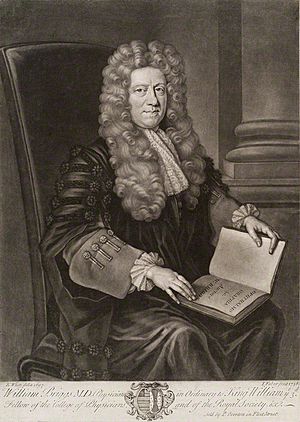William Briggs (physician) facts for kids
William Briggs (1642 – 4 September 1704) was an English doctor who specialized in eye care. He was known as an oculist, which is a doctor who treats eye diseases.
Contents
Early Life and Education
William Briggs was born in Norwich, England, in 1642. His father, Augustine Briggs, was an important person in Norwich, serving as a Member of Parliament (MP) four times.
William started school at Norwich School. When he was just thirteen, he went to Corpus Christi College, Cambridge. He studied there under a teacher named Thomas Tenison. Briggs became a fellow of his college in 1668. He earned his Master of Arts (M.A.) degree in 1670.
Studying Medicine in France
After finishing his studies at Cambridge, Briggs spent several years teaching and learning about medicine. He then traveled to France. There, he attended lectures by Raymond Vieussens at the University of Montpellier. He was supported by Ralph Montagu, who later became the Duke of Montagu and was the British ambassador to France at the time.
Contributions to Eye Medicine
When Briggs returned from France, he published an important book in 1676 called Ophthalmographia. This book was a detailed description of the eye's anatomy. He dedicated it to Ralph Montagu, who had helped him in France.
In 1677, Briggs earned his Doctor of Medicine (M.D.) degree from Cambridge. He became a fellow of the London College of Physicians in 1682.
Theory of Vision
In 1682, the first part of his book, Theory of Vision, was published by Robert Hooke. The second part came out in 1683 in the Philosophical Transactions.
The Theory of Vision was so important that it was translated into Latin in 1685. This was done at the request of Sir Isaac Newton. Newton even wrote a special introduction for it. He praised Briggs for his great skill and knowledge of the eye's anatomy. Newton said he learned a lot from Briggs's work.
A second edition of Ophthalmographia was published in 1687.
Briggs's Discoveries About the Eye
Briggs made several important observations about the eye:
- He recognized that the retina, which is at the back of the eye, is where the fibers of the optic nerve spread out. The optic nerve sends signals from the eye to the brain.
- He also focused on the idea of "vibrations" to explain how nerves work. This was an early way of thinking about how our bodies send signals.
Medical Career and Royal Service
William Briggs became a very successful doctor in London. He was especially good at treating eye diseases.
From 1682 to 1689, he worked as a doctor at St. Thomas's Hospital. In 1696, he became a physician to William III of England, who was the King at the time. He also served as a censor for the College of Physicians in 1685, 1686, and 1692. A censor's job was to make sure doctors followed good medical practices.
Challenges and Later Life
In 1689, Dr. Briggs faced some difficulties. He spent a lot of money trying to help the King keep control of St. Thomas's Hospital. However, he was later removed from his job at the hospital. He believed this happened because of another doctor.
Briggs also said that even though he worked for the royal family for five years, he didn't get paid. In 1698, King William III promised to help him, but nothing happened. Because of these problems, Briggs later asked for his hospital job back.
William Briggs passed away on September 4, 1704, in Town Malling in Kent. His son, Henry Briggs, who was a chaplain to King George II, built a memorial for his father in Holt church in 1737.


